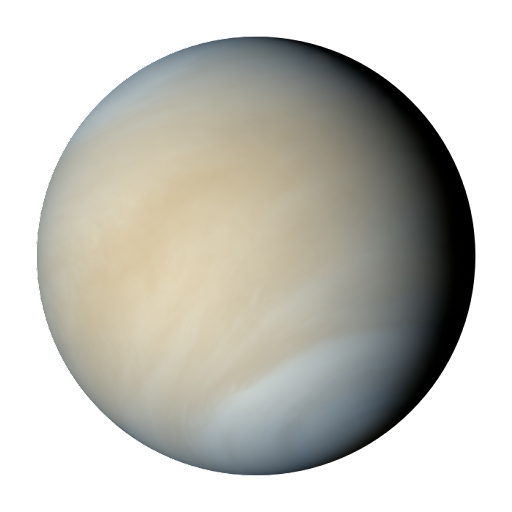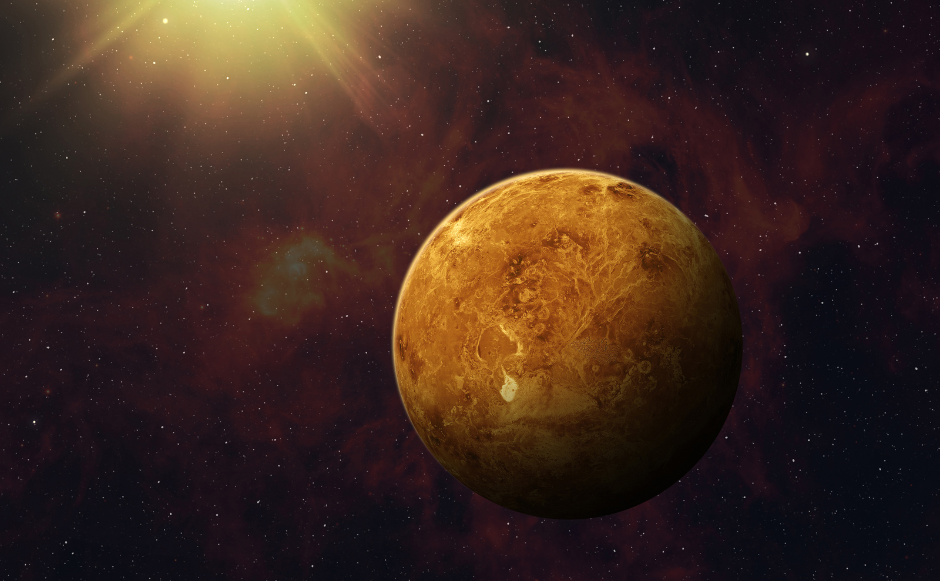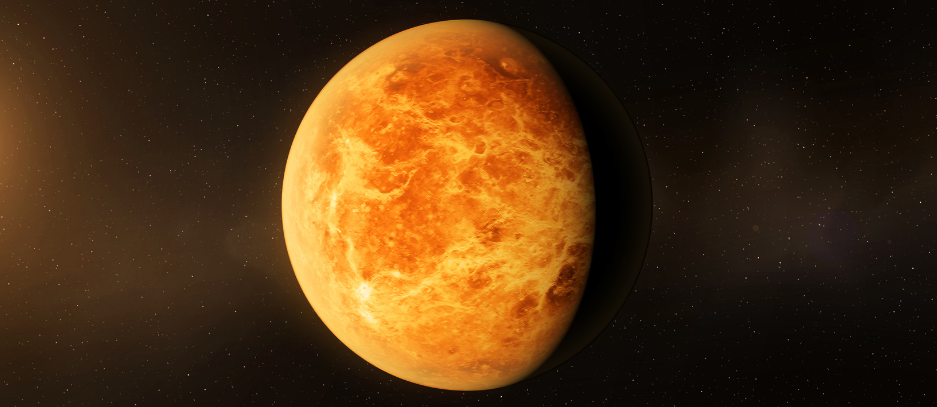A planet worthy of further study at least perhaps? As our understanding of the solar system develops, and technologies advance, could Venus be worth another visit, and just how long would it take to get to Venus? Let’s Explore
Venus – Quick Facts
- Distance From The Sun: 108,200,000 km (67,232,363 mi)
- Radius: 6,052 km (3,761 mi)
- Temperature: 438 to 482°C (820 to 900 °F)
- Day length: 243.1 Earth days
- Year length: 224.7 Earth days
- Number of moons: 0
- Closest Distance to Earth: – As close as 41 Million km in inferior conjunction.
- Furthest distance to Earth: – As far as 257 million km at superior conjunction.

How Far Is Earth From Venus?
The closest that Earth and Venus approach each other is when Venus is at its furthest position from the sun (aphelion) and Earth is at its closest (perihelion), with both planets on the same side of the Sun. This is known as an inferior conjunction and happens roughly once every 584 days. As both planets have elliptical orbits, it is when they are at inferior conjunction at the thinnest part of their orbits that they are truly at their closest.
At it’s farthest, Venus can be as far as 257 million km from Earth on average. At it’s closest, it can be as far as 41 million km from Earth. As the orbit of Venus and Earth does change slightly over time, these closest and farthest distances expand and contract over time.
How Long Would It Take To Get To Venus?

Mission flight times to Venus have varied across different missions. If the aim is simply to get there as quickly as possible while being able to observe, this can be achieved within about 3 months, as with the Mariner 2 mission. But if the goal is to get close enough to enter orbit safely, then this takes longer.
As with travelling to Mercury, because Venus is closer to the Sun than Earth, and objects speed up as they approach the Sun, some of that speed needs to be edged off for orbit to be achieved.
What Is The Shortest Trip?
The shortest successful trip any vessel from Earth has taken so far to reach Venus, was 109/110 days. This was achieved with the Mariner 2 mission which conducted the first successful flyby of Venus. It has been estimated that the Russian Venera 1 spacecraft did reach Venus quicker, at 97 days. However, Venera 1 lost contact with Earth and was not able to be adjusted to pass closer to the planet. This mission was a failure.
The more complex the mission the longer the flight time. These fast missions here were both flybys and could be launched at speed and without the need to slow down to enter a comfortable orbit. Later missions that are more complex have had a longer flight time. Such as the Venus Express mission which had a flight time of 153 days.
How Often Does The Closest Approach Occur?
The close approach between Earth and Venus occurs every 584 days. Interestingly, while Venus is the closest planet to Earth in terms of the alignment of planets in the Solar System, the planet Mercury is actually closer to Earth for more of the time than Venus. That is because Mercury has a much shorter orbital period of the Sun. It spends more time on the same side of the Sun as Earth and reaches inferior conjunction with Earth much more frequently than Venus.

Missions To Venus – All Missions Past, Present And Proposed
There have been lots of missions to Venus. Lots of successful missions but also plenty of failures. In the 1960’s when the space race was in full throttle, there were 5 successful and 13 unsuccessful missions to Venus. All conducted between the fiercely competitive Soviet Union and USA. The USA did have a far more successful ratio of mission success, but also far fewer launches.
From 1970 onward missions to Venus have been far more successful with agency’s learning well from previous setbacks. The USSR in particular sent lots of missions to Venus. When we think of the early space race its common to think of NASA and the Apollo missions, but the USSR in many respects were every bit as ambitious in space.
Successful Missions To Venus So Far
Despite the popularity and highly publicised missions on the red planet, it is Venus that is our most visited cosmic neighbor. There have been more successful and unsuccessful missions to Venus than any other planet in the Solar System. Here are the successful ones so far!
| Spacecraft | Country | Launch Date | Type of Mission | Mission Notes |
| Mariner 2 | USA – NASA | Aug 1962 | Flyby | First successful flyby of another planet. |
| Venera 4 | Soviet Union – Lavochkin | June 1967 | Atmospheric mission | First mission to successfully descend through the atmosphere and send back data. |
| Mariner 5 | USA – NASA | June 1967 | Flyby | Conducted various atmospheric experiments and observations over the course of around 15months. Data from this mission and Venera 4 were shared between the USA and USSR COSPAR working group. |
| Venera 5 | Soviet Union – Lavochkin | Jan 1969 | Atmospheric mission | Successfully entered atmosphere and operated for 53 minutes before landing hard. |
| Venera 6 | Soviet Union – Lavochkin | Jan 1969 | Atmospheric mission | Successfully entered atmosphere and operated for 51 minutes before landing hard. |
| Venera 7 | Soviet Union – Lavochkin | Aug 1970 | Lander mission | Mission only partially succeeded. The first to complete a ‘soft’ landing on another planet. However data sent back was limited as the lander rolled on landing damaging instruments. |
| Venera 8 | Soviet Union – Lavochkin | Mar 1972 | Lander mission | First mission to complete a successful landing intact on another planet. |
| Venera 9 | Soviet Union – Lavochkin | Jun 1975 | Orbital and lander mission | First mission to successfully enter orbit around Venus and to send back images from the surface of another planet. |
| Venera 10 | Soviet Union – Lavochkin | Jun 1975 | Orbital and lander mission | Only the orbiter was disclosed at launch. |
| Pioneer-Venus 1 | USA – NASA | May 1978 | Oribter mission | Conducted many experiments including radar mapping and studying the magnetic properties of Venus. |
| Pioneer-Venus 2 | USA – NASA | Aug 1978 | Atmospheric mission with Four probes | Craft arrived with 1 large and 3 small probes to study the atmosphere from different locations. |
| Venera 11 | Soviet Union – Lavochkin | Sep 1978 | Orbital and lander mission | Mission conducted flyby and landing. Most instruments failed on landing, mission had some successes. |
| Venera 12 | Soviet Union – Lavochkin | Sep 1978 | Orbital and lander mission | Mission conducted flyby and landing. Cameras failed on landing, mission had some successes. |
| Venera 13 | Soviet Union – Lavochkin | Oct 1981 | Orbital and lander mission | Took the first color images of the surface of Venus. First mission to record sounds from another planet. Lander exceeded mission expectations in remaining operatioal for 127 minutes. |
| Venera 14 | Soviet Union – Lavochkin | Nov 1981 | Orbital and lander mission | Lander functioned for 57 minutes, which was longer than the 32 minutes it was designed for. |
| Venera 15 | Soviet Union – Lavochkin | Jun 1983 | Oribter mission | Conducted radar mapping |
| Venera 16 | Soviet Union – Lavochkin | Jun 1983 | Oribter mission | Conducted radar mapping |
| Vega 1 | Soviet Union – Lavochkin | Dec 1984 | Hybrid mission including Flyby and lander with atmospheric probe. | Joint mission to study both Venus and Halley’s Comet. Studied atmosphere by means of probe. Lander studied surface and spacecraft was directed on to the comet. |
| Vega 2 | Soviet Union – Lavochkin | Dec 1984 | Hybrid mission including Flyby and lander with atmospheric probe. | Joint mission to study both Venus and Halley’s Comet. Studied atmosphere by means of probe. Lander studied surface and spacecraft was directed on to the comet. |
| Magellan | USA – NASA | May 1989 | Oribter mission | Conducted radar mapping and HD imagery |
| Venus Express | Europe – ESA | Nov 2005 | Oribter mission | Study of atmosphere, surface and plasma. |
| Akatsuki | Japan – JAXA | May 2010 | Oribter mission | Failed to enter orbit on first attempt but succeeded on second attempt in 2015. Mission still in operation. |
| IKAROS | Japan – JAXA | May 2010 | Solar sail experiment | Experimental craft conducted flyby. |
Venus As A Springboard To Other Planets
As well as the multitude of missions sent to observe Venus, the planet has also been used to aid in sending craft to other planets. Venus has been used in many missions to help correct flight path and velocity in sending craft out into the Solar System, and also for slowing craft down on approach to Mercury. This process is known as a gravity assist, and here are those missions.
| Spacecraft | Country | Launch Date | Type of Mission |
|---|---|---|---|
| Mariner 10 | USA -NASA | 3rd Nov 1973 | Flyby en route to Mercury. Observed surface. |
| Galileo | USA -NASA | 18th Oct 1989 | Flyby en route to Jupiter. Observed surface. |
| Cassini | USA -NASA | 15th Oct 1997 | Flyby en route to Saturn. Observed surface. |
| MESSENGER | USA -NASA | 3rd Aug 2004 | Flyby en route to Mercury. Observed surface. |
| Parker Solar Probe | USA -NASA | 12th Aug 2018 | Several Flybys en route to the Sun. |
| BepiColombo | Europe – ESA | 20th Oct 2018 | 2 Flybys en route to Mercury. Observed surface. |
| Solar Orbiter | Europe – ESA | 10th Feb 2020 | Several Flybys en route to the Sun. |
Failed Missions To Venus
Missions to Venus got off to a rocky start. Most of the early missions in the 1960’s failed to get off the ground or out of low earth orbit. But with each failure came a lesson, an opportunity to adapt. Such is the nature of pioneering. These failures led the way to later successes.
| Spacecraft | Launch Date | Country | Flight Issue | Mission Notes |
|---|---|---|---|---|
| Sputnik 7 | 4 February 1961 | Soviet Union – OKB-1 | Launch Failure | Never escaped low Earth orbit. |
| Venera 1 | 12 February 1961 | Soviet Union – OKB-1 | Spacecraft Coms Failure | Performed first flyby of another planet, but no data returned and the mission was a failure. |
| Mariner 1 | 22 July 1962 | USA -NASA | Launch Failure | Destroyed after launch for safety |
| Sputnik 19 | 25 August 1962 | Soviet Union – OKB-1 | Launch Failure | Never escaped low Earth orbit. |
| Sputnik 20 | 1 September 1962 | Soviet Union – OKB-1 | Launch Failure | Never escaped low Earth orbit. |
| Sputnik 21 | 12 September 1962 | Soviet Union – OKB-1 | Launch Failure | Never escaped low Earth orbit. |
| Venera 1964A | 19 February 1964 | Soviet Union – OKB-1 | Launch Failure | Did not reach orbit |
| Kosmos 27 | 27 March 1964 | Soviet Union – OKB-1 | Launch Failure | Never escaped low Earth orbit. |
| Zond 1 | 2 April 1964 | Soviet Union – OKB-1 | Electronics Fault | Comunications lost before reaching Venus. Flyby achieved but mission failure. |
| Venera 2 | 12 November 1965 | Soviet Union – OKB-1 | Spacecraft Coms Failure | Coms lost before data could be returned following flyby. |
| Venera 3 | 16 November 1965 | Soviet Union – OKB-1 | Spacecraft Coms Failure | Coms lost on entering atmosphere of Venus. No data returned so mission failure. It is believed atmospheric pressure caused critical damage. The craft was the first to enter the atmosphere and impact with another planet. |
| Kosmos 96 | 23 November 1965 | Soviet Union – OKB-1 | Launch Failure | Never low Earth orbit due to damage in later stages. |
| Kosmos 167 | 17 June 1967 | Soviet Union – Lavochkin | Launch Failure | Never escaped low Earth orbit – failure in later stages. |
| Kosmos 359 | 22 August 1970 | Soviet Union – Lavochkin | Launch Failure | Never escaped low Earth orbit – failure in later stages. |
| Kosmos 482 | 31 March 1972 | Soviet Union – Lavochkin | Launch Failure | Never escaped low Earth orbit – failure in later stages. |
| Shin’en | 20 May 2010 | Japan – UNISEC | Spacecraft Coms Failure | Coms failed after launch. |
Future Missions To Venus
Here are missions that are in current development for launch over the next decade. As well as these projects in development, there are a further 10 missions at proposal or concept stage across the various space agencies.
| Spacecraft | Country | Launch Date (Proposed) | Type of Mission |
|---|---|---|---|
| Rocket Lab’s Venus probe | USA – NASA | 2023 | To study the atmosphere by means of an atmospheric balloon. |
| Shukrayaan-1 | India – ISRO | 2024 | Mission includes Orbiter and an atmospheric balloon. This is India’s first mission to Venus as the country ramps up its space program |
| VERITAS | USA – NASA | 2028 | Orbiter mission. |
| Venera-D | Russia – Roscosmos | 2029 | Russia’s first trip back to Venus since the collapse of the Soviet Union. The mission includes an orbiter and a lander. |
| DAVINCI+ | USA – NASA | 2030 | Misison to study the atmosphere by means of an atmospheric probe. |
| EnVision | Europe – ESA | 2031 | Orbiter mission. |